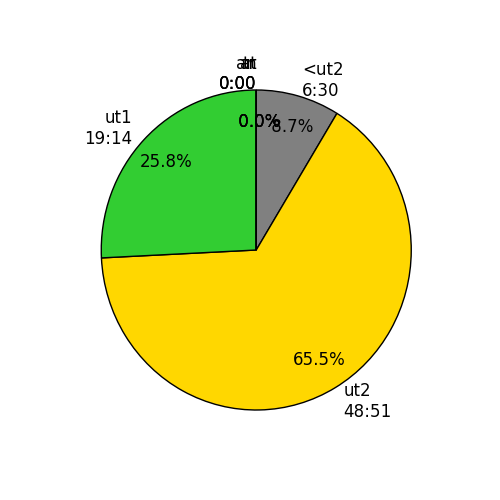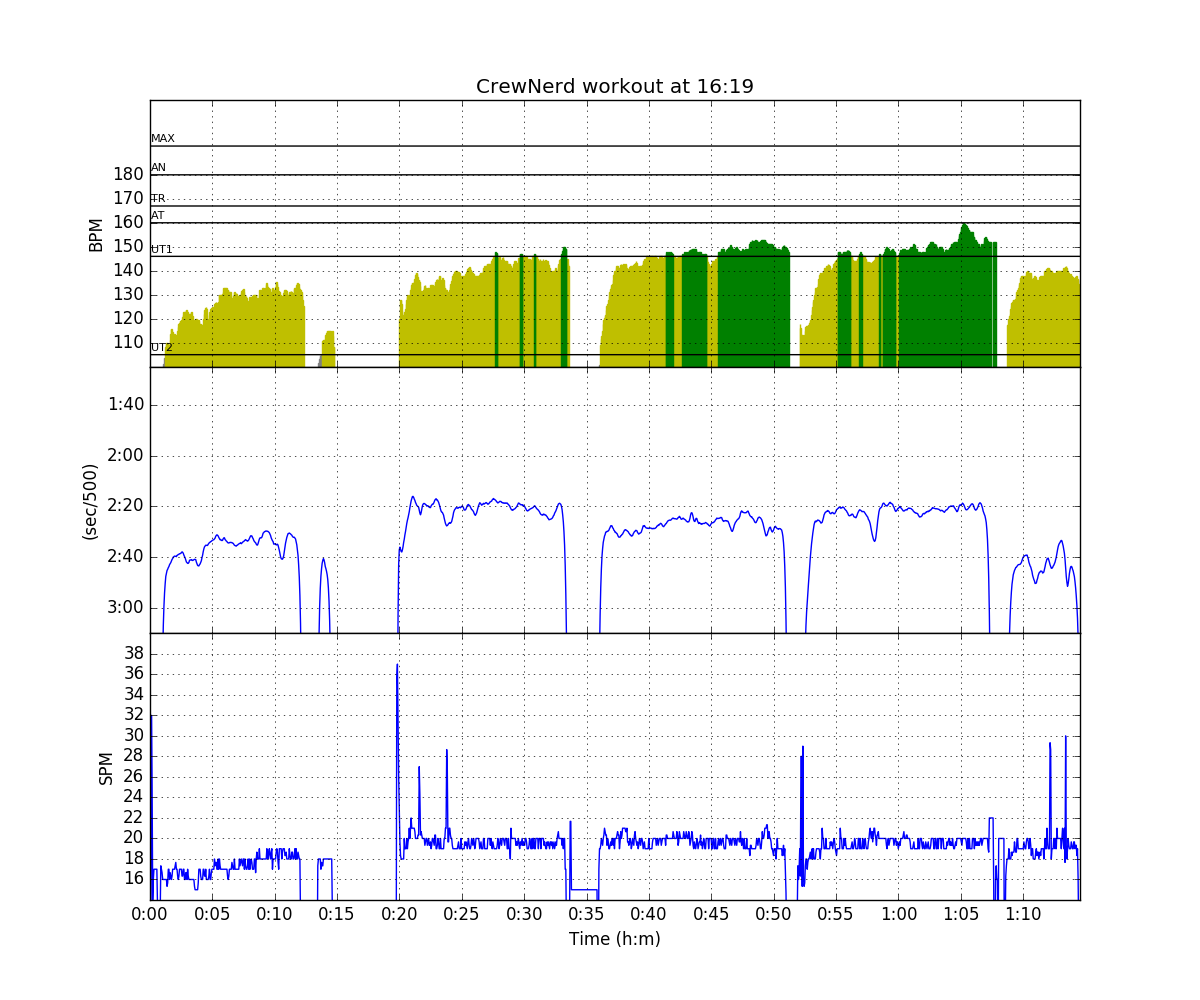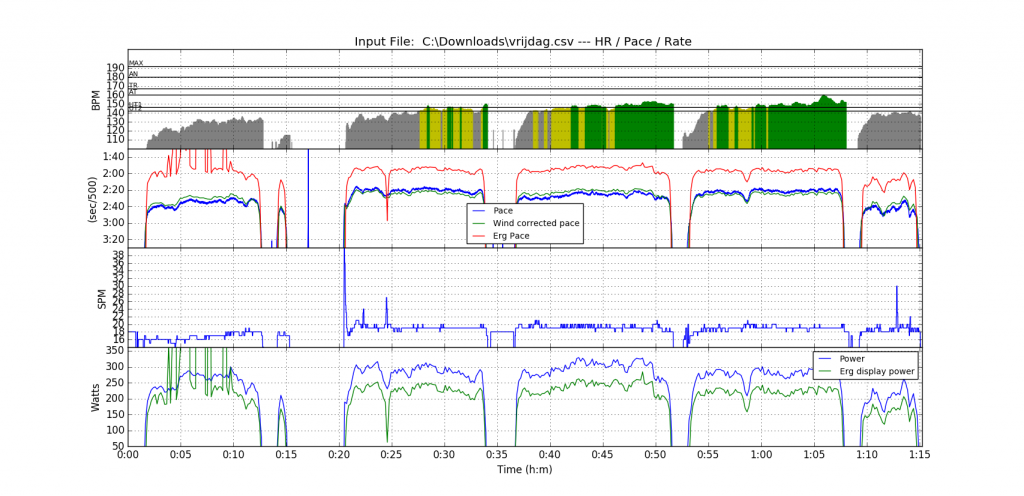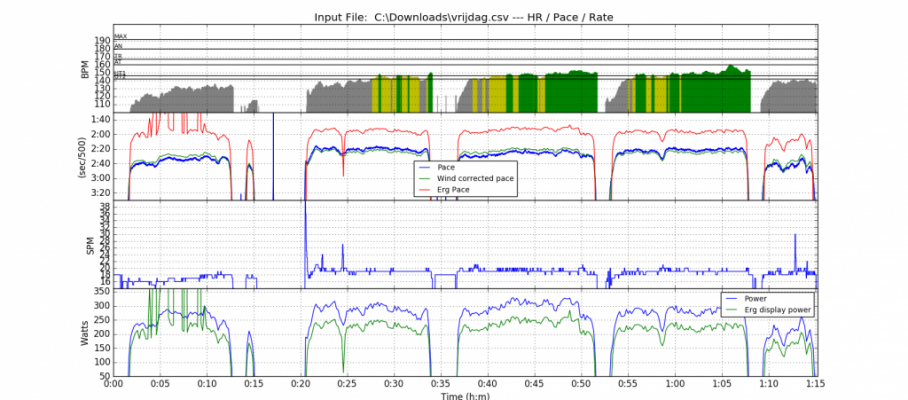Jun 3 2016
Technique & Steady State
Worked from home today. By 4pm we all headed to the lake. In the morning it was damp and humid, gray weather but after lunch it cleared up.
With the races tomorrow, I was conscious not to hit any higher heart rates. So I just rowed and rowed. And rowed. And rowed. Twenty strokes per minute in the single:
Click here for a nice interactive plot of my row


Around 2:20 pace in the light tailwind, 2:30 pace in headwind.
I have been playing a bit with my rowing physics model today. Trying to get the calculation of corresponding ergometer power right. I am not there yet. Here is a plot of what I am trying to achieve:
Looking at my heart rate and how the row “feels”, I would say I was rowing at a pace that on the static ergometer is somewhere around 2:00 – 2:02. My calculations give me something between 1:55 and 2:00. I don’t know about you, but for me the difference between 2:00 and 1:55 is huge. And rowing at 1:58 on the erg, I definitely achieve higher heart rates. Being an experimental physicist by education, I have no ego problems admitting that I am in the stage where theory and experiment don’t match.
(The other explanation would be that I am a superior rower and lousy on the erg.)
Bill Atkinson has, very timely, started the discussion about internal energy dissipation in rowers on rec.sport.rowing. Also today, I received an email from Marinus van Holst mentioning that in anticipation of the Olympics, the Nederlandse Natuurkundige Vereniging (Dutch Physics Society) has devoted the June issue of its Tijdschrift voor de Natuurkunde (Dutch Journal of Physics) to Physics and Sports. Of course, being Dutch, they focus on swimming and speed skating, but still this was interesting enough to order a copy. (I am a member of this society but living abroad I don’t get the journal.)
I am very excited about this. Ultimately, when I have sorted the physics and found something that I understand and is correlating well between my humble OTW and OTE results, I want to offer the erg to water power calculations to the members who register on rowsandall.com.
Racing tomorrow. It’s not exactly Oxford vs Cambridge, but it’s the fourth year in a row of Piestany vs Brno vs Neratovice Masters Eights on the Moldau (Vltava) river in Prague. Sixteen Masters rowers will be disappointed. Eight Masters rowers will feel they own the universe. 🙂





Jun 28 2016
Goodbye long intervals – 4x2km OTW, plus some info on rowsandall.com
The training
Last time I did this workout, 4x2km with 5 minutes rest, was on April 29th. Then I managed a 2:12.2 average, so today I was shooting for “faster than 2:12”.
In line with my plan, this would be the final “long interval” session of this OTW season. After today, it’s “so long, long intervals” until some time in September. 🙂
As I have a day off, I also wanted to take the time and experiment with the footstretcher location. After watching my video, several people suggested to move the footstretcher slightly sternward. So I did, but not immediately. The plan was to row the first two 2kms with the old rigging, and then change. I would take a bit more time between intervals #2 and #3 to move the stretcher and to get a bit more rest, so that hopefully fatigue would not influence the experimental results too much.
Wind was between 1 and 2 m/s varying between North and NorthWest, according to SportTracks, and it was between 2.5 m/s and 3.5 m/s NNW according to WindFinder’s prediction. On the water, I definitely noticed that the wind was growing. Between the tailwind intervals #1 and #3 there was definitely a stronger tailwind in #3, but also the water changed from “ripples” to “small chop”, and I wasn’t faster in #3 (with the new footstretcher setting). For the headwind intervals #2 and #4, pace went down by 3 seconds (from 2:09 to 2:12) with #4 being the slowest interval. Definitely a interval #4 was the hardest battle seeing the slowest splits at some points. I also noticed that interval #4 got quite sloppy in one point. When I realized it, with about 500m to go, I started to focus more on technique, which gave me a few seconds of split in the right direction (it could also have been the effect of a slight turn in the course, which made the wind less head-on and more cross-wind).
More about wind in the second half of this blog. First, the plots:
And the stats:
Workout Summary - media/20160628-105331-2016-06-28-0805.CSV
--|Total|-Total-|--Avg--|Avg-|-Avg-|-Max-|-Avg
--|Dist-|-Time--|-Pace--|SPM-|-HR--|-HR--|-DPS
--|13528|62:39.0|02:17.3|23.9|153.4|163.9|09.2
Workout Details
#-|SDist|-Split-|-SPace-|SPM-|AvgHR|MaxHR|DPS-
01|02980| 15:08 |02:31.5|19.6|131.0|161.0|10.1
02|02000| 08:06 |02:01.5|27.0|165.0|173.0|09.1 | tailwind standing start
03|02000| 08:35 |02:08.9|27.2|172.0|177.0|08.5 | headwind rolling start
04|00781| 04:30 |02:36.2|19.9|134.0|144.0|09.6 | tailwind standing start, footstretcher moved
05|02000| 08:06 |02:01.7|28.2|169.0|176.0|08.7 | headwind rolling start
06|02000| 08:49 |02:12.5|27.4|171.0|177.0|08.3
07|01767| 09:25 |02:40.1|18.1|132.0|139.0|10.3
You can see more on the workout page or the interactive plot on rowsandall.com.
After the session I did some rigging measurements, just to make sure I had all the data, and also to compare with on-line rigging charts for single sculls. The problem of course was that I never measured “work-through” myself, so I measured this differently than the tables. What I measured:
What people measure:
I am actually not sure how people measure this without help, and I am not sure how accurate these measurements are … OK, will do more measurements tomorrow. Also, I forgot to measure footstretcher height and angle.
I will keep the footstretcher at the new position for a while. Boat didn’t feel significantly heavier at the catch.
Uploading trainings to Concept2 and comparing trainings
Regular readers know that I have been building a website to support creating those colorful plots that I show in my blogs. The site is at rowsandall.com. There has been quite an evolution over the past few weeks, probably because I put a lot of my free time into it. So here is an overview of the functionality:
Actually, everything I do on this blog is now going through that site. Bugs are starting to get relatively minor and seldom, so I encourage you to take a look, register, and try it out. Comments here or on rowsandall.slack.com.
That last functionality, comparing workouts, is relatively new, but quite interesting. Here are a few example plots for today’s workout vs the same workout done on April 29th:
The distance axis is not completely similar between the two workouts, because I took more time and distance for the warming up. Still it is clear that I managed significantly higher stroke rates and faster paces today. I call that progress (and perhaps the effect of the low i sculls). It cannot be only due to the warming up of the water …
Geeky stuff
Another thing that I am working on is correction for wind. The trouble is of course to get good wind data. Must develop a portable data logging wind meter for rowers …
Using the GPS track (and some data smoothing) you can calculate the boat’s bearing, and thus its angle with respect to the wind. Decomposing that wind into head/tailwind and crosswind components is then child’s play. Here’s my track of today:
Here is the wind according to SportTracks, taking data from nearby amateur weather stations:
Taking the prediction from WindFinder, the same plot looks like this:
Both plots were generated directly on rowsandall.com using the wind editor. I haven’t implemented wind correction on the site yet, but I have it working on the desktop. Please don’t look at the “Erg Power” and “Erg Pace” lines. They are off and I know it. That’s the next step. As the whole calculation takes about 10 minutes, I need to program this as a “background task”, enabling the users to come back to the calculations once they are done (and sending them a message when that is the case).
As you can see from the second plot, the calculation sometimes fails. Need to look into this a bit more.
Comparing the tailwind section’s comparisons, I think the truth is somewhere between the two plots.
By sanderroosendaal • Uncategorized • 3 • Tags: 4x2km, lake, OTW, rowing, rowing physics, single, wind correction